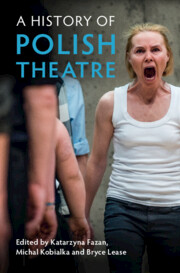Book contents
- A History of Polish Theatre
- A History of Polish Theatre
- Copyright page
- Contents
- Figures
- Notes on Contributors
- Acknowledgements
- A Note on Terminology
- Introduction
- Chapter 1 Where Is Poland? What Is Poland?
- Chapter 2 Staropolski (Old Polish) Theatre
- Chapter 3 The Public Stage and the Enlightenment
- Chapter 4 Romanticism
- Chapter 5 Mapping Theatre (I)
- Chapter 6 Mapping Theatre (II)
- Chapter 7 Modernist Theatre
- Chapter 8 Avant-Gardes
- Chapter 9 Theatre during the Second World War
- Chapter 10 Political Theatres
- Chapter 11 Ritual Theatre
- Chapter 12 Actors and Animants
- Chapter 13 Writing and Dramaturgy
- Chapter 14 Theatre Ontologies
- Index
Chapter 2 - Staropolski (Old Polish) Theatre
Published online by Cambridge University Press: 09 December 2021
- A History of Polish Theatre
- A History of Polish Theatre
- Copyright page
- Contents
- Figures
- Notes on Contributors
- Acknowledgements
- A Note on Terminology
- Introduction
- Chapter 1 Where Is Poland? What Is Poland?
- Chapter 2 Staropolski (Old Polish) Theatre
- Chapter 3 The Public Stage and the Enlightenment
- Chapter 4 Romanticism
- Chapter 5 Mapping Theatre (I)
- Chapter 6 Mapping Theatre (II)
- Chapter 7 Modernist Theatre
- Chapter 8 Avant-Gardes
- Chapter 9 Theatre during the Second World War
- Chapter 10 Political Theatres
- Chapter 11 Ritual Theatre
- Chapter 12 Actors and Animants
- Chapter 13 Writing and Dramaturgy
- Chapter 14 Theatre Ontologies
- Index
Summary
Mirosław Kocur defines ‘Staropolska’ as an umbrella term that is used to bring together multiple social, class, religious, ideological and aesthetic issues that signalled different cultural formations emerging in the period between the twelfth and the eighteenth centuries in a territory which was not ethnically or politically homogeneous. In the same constellation, Agnieszka Marszałek approaches Staropolska from the perspective of spectators and diverse publics and argues that its theatre was ‘a combination of changing ways of demonstrating belonging to various communities and representing specific particular interests, models of behaviour, as well as signalling one’s own presence (and separateness) within what was then called the state, society or the nation’. Marszałek insists that theatre became ‘Polish’ only with the establishment of a public theatre (1765–67). Even then, a knowledge of foreign languages (French, Italian, German) was crucial.
Keywords
- Type
- Chapter
- Information
- A History of Polish Theatre , pp. 44 - 67Publisher: Cambridge University PressPrint publication year: 2022

